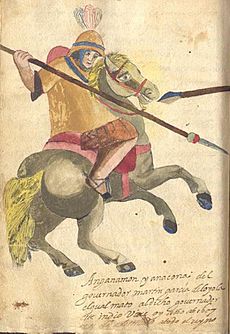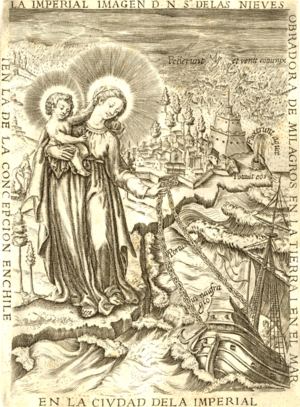Destruction of the Seven Cities facts for kids

The Destruction of the Seven Cities (in Spanish: Destrucción de las siete ciudades) is a name used in Chilean history. It describes when seven main Spanish towns in southern Chile were destroyed or left empty around the year 1600. This happened because of a big uprising by the Mapuche and Huilliche people that started in 1598.
This event is very important in Chilean history. It marks the end of the time when Spain was trying to conquer Chile. It also started the proper colonial period. The Destruction of the Seven Cities had a lasting effect on the Mapuche people and the history of Chile. It shaped how the Spanish and Mapuche would interact for many years, leading to the creation of a special border area.
Contents
What Happened During the Destruction of the Seven Cities?
Years before these events, some Spanish leaders and settlers knew that Spain's control in southern Chile was not very strong. For example, in 1576, a man named Melchior Calderón wrote to the king of Spain. He suggested that Spain should have fewer cities in the south. He thought they should combine some cities to make them stronger.
The uprising began after news spread about the Battle of Curalaba. This battle happened on December 23, 1598. In it, a Mapuche leader named Pelantaru and his helpers, Anganamón and Guaiquimilla, led about 300 men. They ambushed and killed the Spanish governor, Martín García Óñez de Loyola, and almost all his soldiers.
Over the next few years, the Mapuche managed to destroy or force the Spanish to leave many towns and smaller settlements. This included all seven major Spanish cities in Mapuche land south of the Biobío River. These cities were:
- Santa Cruz de Coya (destroyed in 1599)
- Santa María la Blanca de Valdivia (destroyed in 1599, briefly reoccupied in 1602, then left again in 1604)
- San Andrés de Los Infantes (destroyed in 1599)
- La Imperial (destroyed in 1600)
- Santa María Magdalena de Villa Rica (destroyed in 1602)
- San Mateo de Osorno (destroyed in 1603)
- San Felipe de Araucan (destroyed in 1604)
People Affected and Captives
A writer from that time, Alonso González de Nájera, wrote that the Mapuches killed more than 3,000 Spanish people. They also took over 500 women as captives. Many children and Spanish priests were also captured. Skilled workers, Spanish people who had left their side, and women were generally not killed by the Mapuches.
Some Spanish women were rescued in Spanish attacks. Others were set free only after agreements, like the Parliament of Quillín in 1641. Some Spanish women became used to Mapuche life and chose to stay with them. Children born to these captive women were called mestizos. They were not accepted by the Spanish but were welcomed by the Mapuches. These children might have helped the Mapuche population grow. Their society had been badly affected by war and diseases brought by the Spanish.
The taking of women during the Destruction of the Seven Cities led to more Spanish women being taken by Mapuches in the 1600s.
What Happened After the Destruction?
Central Chile Becomes the Spanish Center
When the Spanish cities in the south fell after the Battle of Curalaba in 1598, Spain lost its main sources of gold and native workers. After these difficult years, the Spanish colony in Chile became focused on Central Chile. This area grew in population, was explored more, and became more important for the economy. Much land in Central Chile was cleared for farming during this time.
In contrast, open fields in southern Chile became overgrown. This was because the native populations there decreased due to diseases from the Spanish and ongoing wars. Losing the cities meant that Spanish settlements in Chile became more rural. Large farms called haciendas became very important for the economy and society.
A special border area between the Spanish and Mapuche was set up in the south. This made Concepción the "military capital" of Chile. This was because the Spanish Army of Arauco was based there. This army was paid with silver from Potosí, a payment known as the Real Situado. Santiago remained the political capital from 1578, as it was further away from the war zone.
Chiloé and the "Royal Indians"
When the cities of Valdivia and Osorno were destroyed, Spanish settlers and loyal native allies called yanakuna moved south. They avoided hostile Cuncos and Huilliches. When they reached the Chacao Channel near the Chiloé, the refugees were given two new places to settle: Calbuco and Carelmapu.
The yanakuna who stayed loyal to the Spanish during these hard times were rewarded. They did not have to do forced labor anymore. They also became part of a special army and were paid by the Real Situado. Because of this, they became known as Indios reyunos, which means "Royal Indians." About 300 of the first 600 Royal Indians settled in Calbuco.
The Destruction of the Seven Cities made the settlements in Chiloé an isolated area. They were cut off from the rest of Spanish Chile. This meant the region developed as a very distant and separate Spanish outpost.
Dutch Interest in Valdivia
The abandoned city of Valdivia became an attractive spot for Spain's enemies to control. If they held it, they could set up a base right in the middle of Spain's lands in Chile. The Spanish knew this. They tried to take Valdivia back in the 1630s, but the Mapuches stopped them. The Dutch briefly took over Valdivia in 1643.
The Spanish viceroy in Peru, Pedro de Toledo, 1st Marquis of Mancera, heard that the Dutch planned to return to Valdivia. So, in 1644, he sent 1,000 men in twenty ships to resettle Valdivia and build forts there. Another 2,000 men were sent by land, but they never made it.
Spanish Thoughts on the War
The difficult situation of Spanish control over Chile in the 1600s led people to compare it to the Eighty Year's War in Europe. Diego de Rosales thought Chile had become an "Indian Flanders." Purén indómito, a book written around the time of the Destruction of the Seven Cities (1598–1600), describes these events. It is known for being very realistic and honest. It also criticizes both the Spanish and Mapuche actions. This book, along with a military analysis called La guerra de Chile (published in 1647), changed how the Spanish viewed the conquest of Chile. They had often seen it as a grand story of "victories."
 In Spanish: Destrucción de las siete ciudades para niños
In Spanish: Destrucción de las siete ciudades para niños



